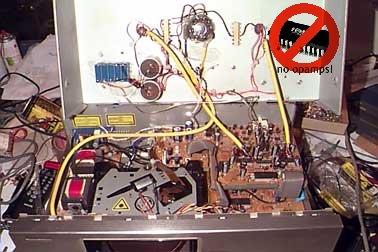tube output stage for single ended voltage output sigma-delta DACs
last update: May 11, 2002

|
\ /

 Well, anyway, the current trend is towards multi-bit sigma/delta dacs. Sigma/delta is a great principle, but due to the huge amount of quantisation noise, the feedback loops need to be of a high order, which can lead to instability and limit cycles.
So, a few bits (it's about 4 to 6 bits, usually) were added so that the sigma/delta loop may be simpler. With one bit, a simple inverter yields a differential output. With more bits, it's a little bit harder so those dacs usually have single ended outputs.
Many have asked me how to make an output stage a la CD enhancer II with a single ended voltage output dac. One put his money where his mouth was and lent me an NAD C541 with the Burr-Brown PCM1732 dac. This dac also features an HDCD filter, directly ported from the Pacific Microsystems filter.
Well, anyway, the current trend is towards multi-bit sigma/delta dacs. Sigma/delta is a great principle, but due to the huge amount of quantisation noise, the feedback loops need to be of a high order, which can lead to instability and limit cycles.
So, a few bits (it's about 4 to 6 bits, usually) were added so that the sigma/delta loop may be simpler. With one bit, a simple inverter yields a differential output. With more bits, it's a little bit harder so those dacs usually have single ended outputs.
Many have asked me how to make an output stage a la CD enhancer II with a single ended voltage output dac. One put his money where his mouth was and lent me an NAD C541 with the Burr-Brown PCM1732 dac. This dac also features an HDCD filter, directly ported from the Pacific Microsystems filter.
The clock in the C541 is 16 MHz, which was embedded in foam in order to reduce mechanical induced jitter. Not bad. However, replacing it with a low-jitter clock with clean HF filtered supply did a lot for transparency and imaging.
 The CDenhancerII concept has really proven itself over the last year, so I decided not to deviate too much. So I just cut the PP schematic in half and ended up with a single ended schematic. This however called for a 9:1 tranny that could pass DC, while the older PP trannies couldn't.
A call to Wil Blaauw from AE Europe did the trick: he wound me some C-core trannies (ordering number 24758) that would pass up to 30 mA DC. The 5687 I had in mind runs on 12 mA so headroom is not an issue.
Nicely potted in prefab housings, this player looks even better than my own, which is still waiting for its casing...
The CDenhancerII concept has really proven itself over the last year, so I decided not to deviate too much. So I just cut the PP schematic in half and ended up with a single ended schematic. This however called for a 9:1 tranny that could pass DC, while the older PP trannies couldn't.
A call to Wil Blaauw from AE Europe did the trick: he wound me some C-core trannies (ordering number 24758) that would pass up to 30 mA DC. The 5687 I had in mind runs on 12 mA so headroom is not an issue.
Nicely potted in prefab housings, this player looks even better than my own, which is still waiting for its casing...


Furter modifications included the almost standard appliance of lead bitumes and power supply filtering. Do I even need to elaborate on its virtues? I didn't think so... ;-)


Since this CD enhancer is single ended, the power supply has some heavier buffering. Nothing cancels out. I opted for a choke input supply because of the excellent voltage regulating capabilities of such a setup.
| V2 | EZ80 | Philips Miniwatt (private stock) |
| V3, V4 | 5687 | Tung-Sol black plate (private stock) |
| Tr1,Tr2 | mains transformer | Automatic Electronic 24756 |
| L1 | choke | Automatic Electronic 24757 |
| Tr3,Tr4 | output transformer | Automatic Electronic 24758 |
| Rx | resistors | Allen Bradley (private stock) |
| wiring | teflon insulated silver (private stock) | |
| C7, C8, C10 | Sprague electrolytic capacitor | private stock (ham) |
| C9 | electrolytic capacitor | Os-con |
| C4 | PIO cap | private stock (ham) |

Upon the first startup, it's never very good. Too bright, and quite harsh. The harshness comes from the 5687 that has to break in and the brightness (or lack of bass actually) is due to the transformer that needs to settle as well. With top trannies like these, you can only fairly judge them after a week of non-stop playing music. However, after half an hour already, this player started to sing. It sounded really lush and open. Very spatial. It did remind me of the classic PCM63 sound character. This sigma/delta dac sounds more like that old PCM dac than like my pioneer. Both have their cons and pros. I like the naturalness and laid back sound of the legato in the Pioneer but the crisp sound of the Burr-Brown as well and could very well live with both.